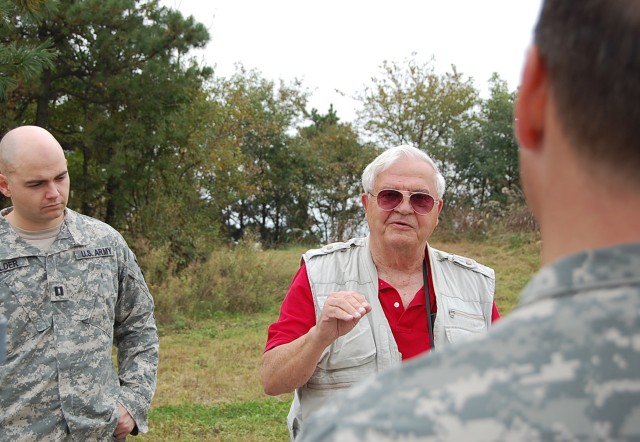HUMPHREYS GARRISON, South Korea - Soldiers from the 36th Signal Battalion, 1st Signal Brigade, which is spread throughout the Korean peninsula, received a special history lesson Oct. 14, while "making the day" of someone who had last been stationed in Korea in 1955.
Robert S. "Bob" Furrer, a retired Air Force Reserve major from Lake Oswego, Ore., was last stationed in Korea in 1955 at a place known as High Point Site, on a mountain near Cheonan, about 40 kilometers south of here. He said that during this time the site was also known as "Paris." At that time, all of the similar sites located in Korea had names of world capitols and were operated by different elements of the 2nd Radio Relay Squadron, 5th Communications Group.
He has been trying for many years to get back and see the site and thanks to members of the unit, and his willingness to participate in an Officer's Professional Development session, he was able to visit and impart a historic view to officers from the unit.
Today, High Point is one of few digital microwave units maintained by the 501st Signal Company, which falls under the 36th Signal. In 1954-1955, Furrer was the commander of a mountaintop encampment where the airmen assigned to his unit helped provide communications.
"Because of the remote location away from K-55 (now Osan Airbase) and K-6 (Humphreys Garrison) we pretty much had to be self-sufficient," Furrer said. "During that time, we had a group of 18 to 24 airmen, usually one officer and noncommissioned officer, along with someone to cook, take care of supply, drive vehicles and we also had a group a paid Korean laborers."
He added that the Korean labor staff consisted of an interpreter, carpenter, mechanic, and cooks, along with those who were either general laborers or house boys. The labor force assisted in loading and unloading various supply trucks and transporting water from a spring down the mountain.
"There was one guy, we called him 'Superman,'" Furrer said. "He was able to use an A-frame contraption to carry four or five five-gallon Jerry Cans of water to the kitchen and showers. Those cans were not easy to carry, let alone carrying several at a time."
He did go on to tell them about many facets of life and operations during his time at High Point. Being that they were on a remote site, Furrer said that they did have to "pretty much make their own entertainment, except for the occasional 16 millimeter films we would trade with the other remote sites. We watched a lot of 'Three Stooges,' back in the day."
Playing cards were hard to come by, so he wrote to Harold's Club in Reno, Nev., to see if they could spare a few decks of used cards. The club responded by sending them a box filled with new cards, dice, napkins, coasters, several posters and vehicle attachments.
"Like I said, we did the best we could with what we had," Furrer said.
As the commander of the outfit, he told the OPD class that his philosophy was always "Take care of the men and they will take care of you." He believed that if you had to send discipline problems to squadron, it was a sign of poor personnel management and leadership.
Thinking about it now, Furrer said that the year went pretty quickly. After receiving his orders, he returned to the States on May 30, 1955, but he never forgot about his year at High Point. After completing his active duty commitment, Furrer finished his degree in architecture at the University of Oregon and spent 33 years in the planning profession, primarily as a consultant operating throughout the Pacific Northwest.
"This was a perfect way for the younger officers in the battalion to get a history lesson of where we have come from as a profession," said Lt. Col. Mark Rosenstein, battalion commander and a Signal Corps historian. In appreciation of Furrer's taking the time to speak with the Soldiers, Rosenstein presented him with several tokens of the unit's appreciation, including a pin representing the unit crest. Then Furrer joined the Soldiers in having MRE's for lunch, which led to a couple more stories.
"The 55 years in time passage and almost unbelievable change, makes for little of the past to remain, except memories," Furrer said. "But, I am most appreciative of being able to cap my tour of Korea with a visit to the old site."


Social Sharing